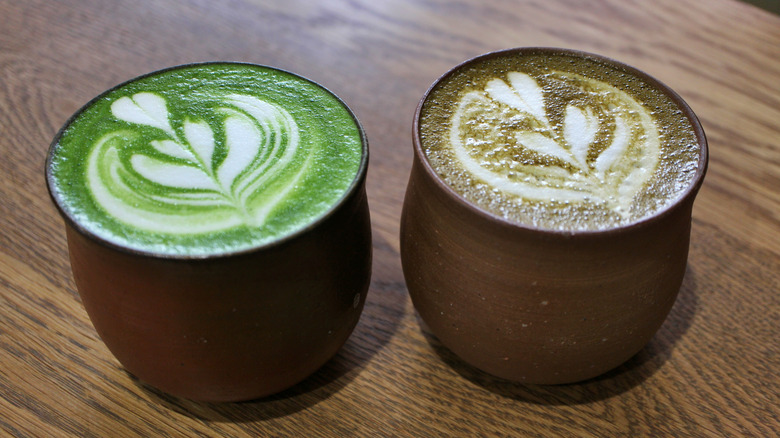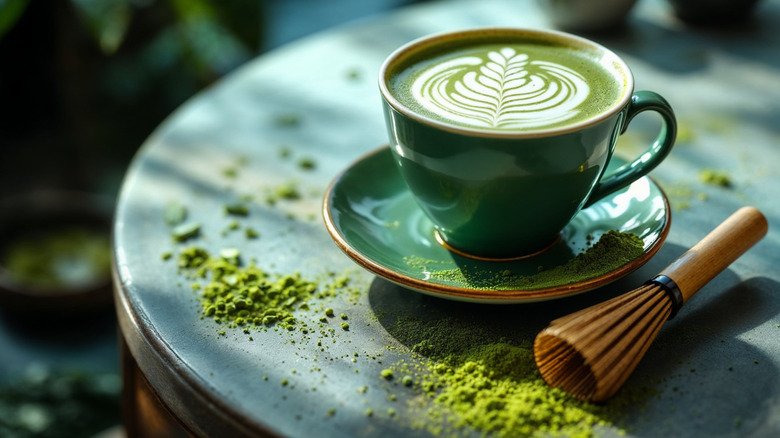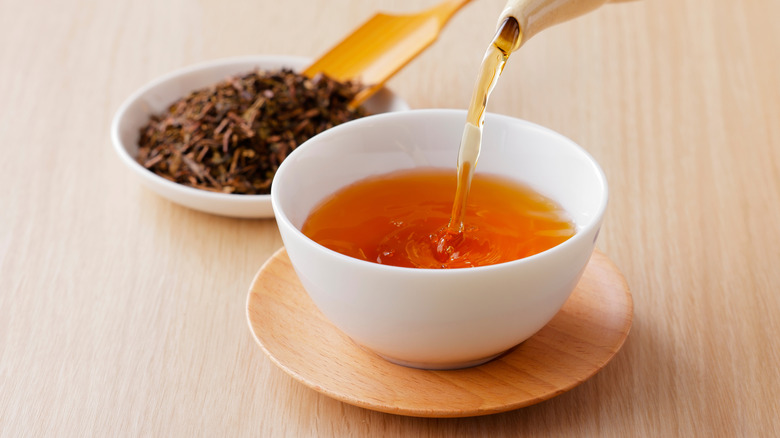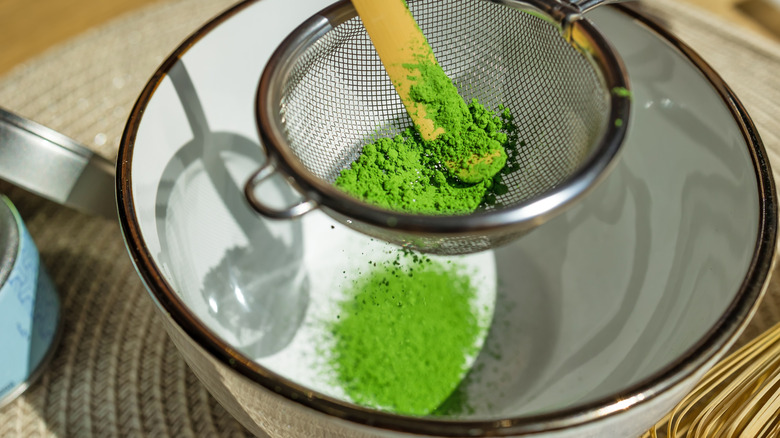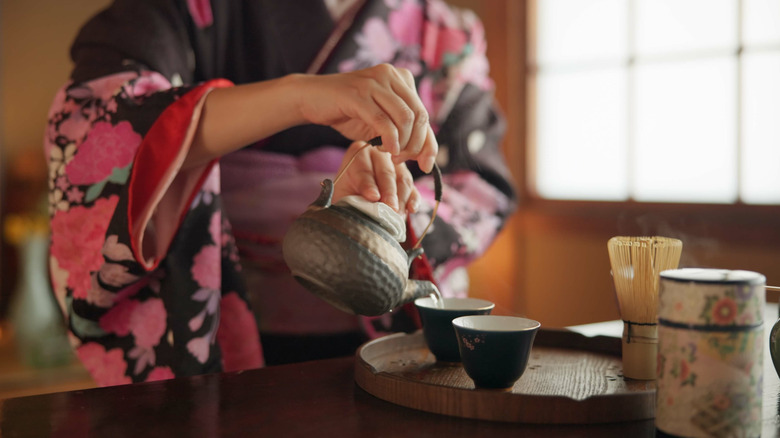Matcha Vs Hojicha Tea: What's The Difference?
We may receive a commission on purchases made from links.
Tea is a wondrous plant. The leaves of the Camellia sinensis species are transformed into an enormous diversity of beverages, and few examples more prominently showcase this malleability than matcha and hojicha. Both are green teas that come by way of Japan, oftentimes harvested in the same region, and appear in powdered form — enough overlapping qualities to cause understandable confusion. Sample the brewed products side by side, though, and you might be shocked they even originate from the same plant.
From cultivation to brewing, the tea leaves are handled in completely distinct ways. While matcha is treated to highlight the qualities of young tea plants, hojicha is a savvy way of using excess leaves. The former goes through a meticulous process of harvesting, sifting, and grinding, optimizing its vibrancy along the way. Meanwhile, hojicha consists of roasting various tea plant parts, a process that imparts a distinct taste and reduces strength. So, while matcha is among the teas with the most caffeine, hojicha offers a more soothing experience. Accordingly, the palate differs, too: Hojicha's pleasantly sweet and roasted notes are quite distinct from matcha's complex, grassy flavors. Nevertheless, both teas are commonly enjoyed in Japan and abroad. Sipped on their own, turned into lattes, or used in baking and cooking, they're a display of uniquely processed green teas equally worth the attention.
Matcha is made from powdered young tea plants
Just take a sip and it's immediately clear that matcha is unlike other types of green tea, especially hojicha. Although composed of the same tea plant, matcha is cultivated specifically to promote the qualities of young tea. The unique processing even initiates before harvest: The leaves are obscured from direct sunlight for part of the growing duration, heightening their vivid green color and complex flavors. The tea subsequently comprises several harvests, with the earliest gathering deemed the highest quality.
The picked product is steamed — rather than the roasting employed for hojicha — and then dried in an oven. The stems are then removed and the tea is comprehensively sifted and blended to create shelf-stable tencha. While rare, such a product — yet to be called matcha since it's not ground — can also be sold as a loose leaf. More often, the leaves are turned into a powder, traditionally via a meticulous granite-made mill. Achieving the ideal fine consistency requires tedious effort, but rewards with the fluffy, powdery texture matcha is known for.
The combination of the complex production process and the impact of growing conditions causes matcha to strongly reflect its terroir. The tea offers flavors ranging between umami, grassy, sweet, and bitter, encompassing intricate flavor combinations. Exporters abroad market matcha into unregulated grades such as ceremonial or culinary, but in Japan, the tea is instead evaluated per its origin and producer. All the while, matcha contains caffeine — magnitudes more than hojicha — making it an enthralling and energizing beverage.
Roasting of leaves and stems creates hojicha tea
A sharp contrast to the painstakingly selected leaves used for matcha, hojicha is made from a variety of green tea harvests without shading. Hojicha doesn't come with matcha's scrutiny over origin and quality because it was invented to reclaim typically discarded stems, leaves, and stalks. Rather than simply throwing away such organic material, tea producers started roasting them over charcoal. Such a heat application dramatically transforms the green tea, darkening its color, altering the flavor, and even affecting the composition.
Hojicha is lower in both caffeine and tannins, creating a distinct type of green tea. As opposed to matcha's pick-me-up capabilities, the resulting tea is more gentle in nature with less of an invigorating effect; the lower tannin content also decreases astringency, easing drinkability. Less bold than matcha, hojicha instead tastes smoky, earthy, and sweet, though the intensity of roasting and employed tea parts vary per producer, impacting the palate. Subsequently, hojicha occupies a more casual realm in tea-drinking. Like matcha, hojicha is also found in powder form, making it a similarly delicious candidate for lattes. Just keep in mind that the tea's characteristic smoky notes turn more nutty when ground.
The two teas shine via different brewing methods
With such contrasting production and flavors, it's no surprise the brewing approach accordingly shifts per tea. Since it's often found in tea bags or loose-leaf form, hojicha is steeped like most other green teas. The product's low caffeine and tannin content make it a forgiving brew, and entails an unusually dense steeping of 8 grams of hojicha per 6-ounce cup. The tea's flavors shine via a range of infusion methods — as long as the brewing temperature remains moderate to promote sweetness. Hojicha is malleable; it can be flash-chilled into ice tea, served alongside milk, or even cold-brewed.
Meanwhile, matcha preparation entails a more potent and calculated process. Rather than steeping, the tea's meticulously whisked into hot water. Unlike hojicha, the technique entails dedicated gear: A sifter to break up clumps, a bamboo-made whisk called a chasen for even frothing, and a properly-shaped bowl for mixing and serving. It's tricky — if not impossible — to achieve suspended matcha without such equipment, necessitating the purchase of a Joiish matcha set. Meanwhile, powdered hojicha dissolves readily via more typical stirring methods. More concentrated than loose-leaf hojicha, matcha employs only 1 or 2 grams of tea per batch, although proportions are doubled for a denser version called koicha. Regardless, when matcha is vigorously stirred with hot water, it forms an unmistakable frothy consistency. Delicious on its own, matcha can also be enjoyed iced or alongside milk and optional flavorings in like strawberry in a spring-inspired latte.
Matcha and hojicha are consumed in different contexts
The two teas occupy different roles in Japanese tea culture. While hojicha has only existed for a bit over 100 years, matcha's consumption in Japan dates back to the 12th century. From inception, matcha garnered a special prominence. The first seeds were introduced by a Buddhist monk returning from China, and cultivated around Kyoto's temples. Soon after, the technique of shading matcha emerged, as well as specific rituals surrounding preparation and serving. By the 16th century, the tea intertwined with an established ceremonial practice that often took place in monasteries — a still active cultural tradition.
In combination with the precise cultivation standards and its diverse, complex palate, matcha cemented itself as a premium beverage. Today, matcha is elegantly presented in tea houses, served at temples, and turned into elaborate confectionery. With the highest quality varieties sold at steep prices, it's a beverage with a premium status akin to coffee and wine. Conversely, hojicha's crafty reuse of excess tea scraps meant the tea came with more accessible prices from the get-go, and it doesn't carry such cultural significance. Instead, hojicha's less bold nature makes it a casual tea style enjoyed throughout the day, especially surrounding mealtime. Its less-complex (but still tasty) palate melds delectably with food, so restaurants in the Kyoto area often offer the tea. Nevertheless, both matcha and hojicha are now popular in Japan. A sip of either delicious option is never far away.
